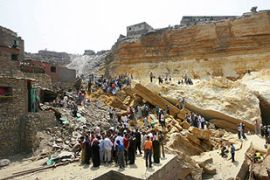Hundreds buried in Cairo rockslide
Huge boulders bury people inside scores of homes in moutain landslide.

“I went out and I saw the whole mountain had collapsed.”
Slow response
Relatives and neighbours dug with their hands among the rubble for survivors or bodies, while police brought in sniffer dogs to locate those trapped.
Soldiers from the Egyptian military used heavy machinery to lift the rocks, some weighing between 60 and 70 tons.
 |
|
Rescue teams struggled to make progress because of the size of the boulders [AFP] |
Locals were enraged at what they said was as an inadequate response by the government.
Witnesses described hundreds of weeping and screaming family members cursing the local authorities and saying they had relatives and friends trapped beneath the rubble.
“You’ve just got your hands in your pockets, you’re not doing anything!” one man yelled at police nearby.
Another said: “If it were the Shura council [Egypt’s upper house of parliament], you’d have had the army in by now,” in reference to a fire at the parliamentary building in August.
Hussein Abdul Ghani, Al Jazeera’s Egypt bureau chief, said: “Rescue teams and civil defence employees do not know what to do or how to rescue those trapped under the debris”.
Potential danger
| Recent Egyptian tragedies |
|
September 6, 2008: Hundreds feared dead in Manshiyet Nasron rockslide. July 16, 2008: Train plows into cars in Marsa Matrouh, killing 40 people and injuring 50. January 1, 2008: Bus plunges into Nile killing 19 people. April 18, 2007: Head-on collision between school bus and truck kills 18 students. August 20, 2006: Nile Delta train collision kills 57 people. February 3, 2006: More than 1,000 passengers die after Egyptian ferry sinks en route to Saudi Arabia. |
Abdul Ghani said the cause of the landslide could have been from a contractor who was carrying out construction work at the top of the mountain.
Al Jazeera’s Lina Ghadban in Cairo, said the fallen rocks and narrow streets were hampering the military in its rescue attempts.
“They have to do it delicately so they don’t add to the destruction through the use of any heavy machinery that could bring down more rocks from the mountainside”.
Manshiyet Nasr residents had informed the authorities a year ago that there was a split between the rocks which posed a potential danger to the homes below.
A similar landslide had occurred in 1994 in the area when 30 people were killed by a falling rock.
Overcrowded village
Manshiyet Nasr is a small village regarded as overcrowded with most families sharing a single room in apartment buildings.
The town’s buildings are cramped at the base of the Mouqattum hills next to a main highway into Cairo.
In a survey carried out by UN Habitat, a human settlement programme, Manshiyet Nasr is described as “the largest squatter, informal area in Cairo. There are 350,000 persons living in this area on about 850 acres with a gross residential density more than 400 persons per acre”.
“The area is suffering from poor living qualities, inadequate services, lack of infrastructure, and deteriorated environmental conditions,” the survey said.
In 2003, the housing ministry, under the auspices of the Suzanne Mubarak, the wife of the Egyptian president, launched a campaign to provide housing for some of the poorest Cairo residents, including in the affected town.